Language learning cannot be separated from the environment, and the environment for second language acquisition is becoming more and more perfect and ideal. It makes the traditional single and limited English learning environment gradually move towards a three-dimensional and diversified learning environment. On the premise of the great development of higher education in China, this study aims to conduct research and discussion on higher English teaching. In combination with other successful or well functioning higher English teaching reforms, it studies and discusses some problems faced in the construction and implementation of vocational English teaching application system in China, and finds solutions and methods. Therefore, this study has practical significance for the reform and development of higher English education in China. This manuscript is based on the design of the college English teaching system module of Web technology to realize the sharing of information resources. In addition, with the deepening understanding of the importance of English teaching in colleges and universities, improving English level and English teaching level is the goal of colleges and universities. English teachers urgently need to understand the factors that affect students’ English level in order to teach students in accordance with their aptitude and find the best teaching methods. The experimental results show that the system realizes the management, query and sharing functions of open level information, and has high security and interactivity. The development of the system conforms to the development trend of network information technology and promotes the informatization and standardization of college English teaching management.
In recent years, the state has made great efforts to develop English teaching in colleges and universities. This year, the state has also proposed that some undergraduate colleges and universities should also turn to the direction of professional education, which fully demonstrates that the state and the government attach importance to higher vocational education in the new situation, and have a more precise positioning for higher vocational education. In this situation, as an important part of higher education, English education is also facing great challenges [1,2]. How to make English education keep up with the reform of higher education is a problem that needs to be solved in front of the society, educators and colleges [3]. As a teaching subject from junior high school to college, English education cannot meet the requirements of social development if it continues the past education model [4]. From a micro perspective, it will affect a student’s career development, and from a macro perspective, it will affect the development process of the whole society [5].
In terms of teaching and examination evaluation system, English education majors in many domestic colleges and universities have always followed the practice of national ordinary undergraduate colleges and universities, and most of them teach and evaluate students who will engage in English education in the future in colleges and universities in the form of book teaching and test results [6,7]. Under this kind of teaching and evaluation system, students repeat the days when they recite English words and do English test papers in middle school. They don’t know what direction they are working towards when they learn English for the test. The current teaching situation of English education major in colleges and universities restrains students’ enthusiasm for learning and ignores the improvement of students’ professional skills. As a result, the overall teaching level of English teachers has declined [8]. How to stimulate the learning enthusiasm of college English education students and improve their necessary skills in future employment is an important problem to be solved for college English education majors.
As a standardized test that all college students must take, College English Test (CET) still has the necessity of existence and the prospect of development [9,10]. As a national standardized test, the College English Test meets the basic requirements of the College English syllabus, and can ensure the scientific nature of the test questions, the strictness of the organization, and the fairness of the results. This reflects the requirements of more and more international exchanges on the English ability of college students in China, and also reflects the important standards of social recruitment units on the English ability of college students when selecting talents [11,12].
To sum up, the reform path optimization and three-dimensional review of college English education system driven by information technology in the new era is an inevitable choice under the proposition of the times.
The process of economic globalization is speeding up gradually. Various resources are increasingly integrated in the global scope. The market is also increasingly refined. International exchanges are increasingly strengthened. As an international common language, the demand for talents in different industries is also rising, and there are great differences. The main task of colleges and universities is to cultivate advanced front-line technical production and service management talents with international cooperation and exchange capabilities. Therefore, they need to keep abreast of the trend of the times, grasp the market trend. In the process of English education construction, they should also adhere to the principle of cultivating students’ “application ability”, and gradually embark on the career path. Nowadays, English education in colleges and universities is highly popular [14]. All colleges and universities set up English classes according to the requirements of the Ministry of Education, which generally lasts for four semesters. In recent two years, some colleges and universities have tried three semesters. However, the overall teaching situation is not optimistic. Looking at the current higher English teaching, there are still many weak links. To sum up, there are the following aspects On the one hand, teachers who undertake English teaching tasks in colleges and universities generally have received ordinary undergraduate education. Therefore, although they are teachers in colleges and universities, some of them have no background in English teaching, so they cannot scientifically understand higher education. Due to the particularity of education, it is impossible to fully understand the modern concept of education, and the state of students often makes them confused, which will cause English teaching to be out of touch with reality [15]. At present, the source of English teachers mainly comes from English majors. They have solid basic English skills, but at the same time, they lack the industry knowledge required for advanced professional development, and some even lack teaching knowledge, which is very important in the teaching industry. becomes a disadvantage when it comes to English. We must keep pace with the times and become the dual-qualified teachers that the society needs. Its S-P table is shown in Table 1.
| – | P6 | P1 | P2 | P3 | P4 | P5 | Total score | % | CS |
| S1 | 1 | 1 | 1 | 0 | 1 | 1 | 5 | 83 | 1.2 |
| S4 | 1 | 0 | 0 | 1 | 1 | 1 | 4 | 67 | 1.29 |
| S2 | 1 | 1 | 1 | 0 | 0 | 0 | 3 | 50 | 0 |
| S3 | 1 | 0 | 0 | 1 | 0 | 1 | 3 | 50 | 0.29 |
| S7 | 0 | 1 | 1 | 1 | 0 | 0 | 3 | 50 | 0.14 |
| S8 | 1 | 0 | 1 | 1 | 0 | 0 | 3 | 50 | 0 |
| S10 | 0 | 1 | 1 | 0 | 1 | 0 | 3 | 50 | 0.29 |
| S9 | 1 | 0 | 0 | 0 | 1 | 0 | 2 | 33 | 0.6 |
| S5 | 0 | 0 | 0 | 1 | 0 | 0 | 1 | 17 | 0.75 |
| S6 | 0 | 1 | 0 | 0 | 0 | 0 | 1 | 17 | 0.75 |
On the other hand, we all advocate student-centered teaching nowadays, but in actual teaching, we still adopt the teaching method of full class. After a class, teachers work hard and students work hard to take notes, but they can’t effectively transform knowledge into ability. At the end of a semester, students take all kinds of traditional English tests. Some schools even arrange the tutoring of the test in the normal classroom teaching in order to achieve a high pass rate, which disturbs the normal English teaching. Old English teaching ideas will affect the teaching effect. Finally, students can pass all kinds of English tests, but they can’t speak it out and can’t be used in practical work [16]. This kind of blind test passing rate of colleges and universities creates the illusion of vitality in English learning, but they dare not move forward once they arrive at the workplace. This concept and teaching mode of taking the exam, as well as the cognitive deviation of teaching management departments and front-line teachers, result in batches of graduates who cannot speak or understand, which is a great waste of resources. Now students are faced with various information channels. They are no longer blindly following what they see from books. Teachers’ previous teaching concepts should also change accordingly. Teachers’ role should also change from the former leader to the guide and cooperator, forming a new type of teacher-student relationship. The direction of cultivating students is from cultivating students to master some fixed English knowledge to allowing students to learn independently, Master the methods of learning and using English.
The definition formula of support is as follows:
\[\label{e1} \text{Support}(X \to Y) = \frac{{P(X \cup Y)}}{{P(I)}}, \tag{1}\] \[\label{e2} \text{Confidence}(X \to Y) = P(Y\mid X) = \frac{{P(X \cup Y)}}{{P(X)}}, \tag{2}\] \[\label{e3} ;\operatorname{Lift} (X \to Y) = \frac{{P(Y\mid X)}}{{P(Y)}}. \tag{3}\]
The definition formula of the information gain rate is as follows:
\[\label{e4} {\text{GainRatio }}(A) = \frac{{\operatorname{Gain} (A)}}{{\operatorname{SplitInfo} (A)}}, \tag{4}\]
\[\label{e5} \operatorname{Gain} (A) = \operatorname{Info} (D) – {\operatorname{Info} _A}(D), \tag{5}\]
\[\label{e6} \text{Splitinf}{o_A}(D) = – \sum\nolimits_{j = 1}^v {\frac{{|{D_j}|}}{{|D|}}} \times {\log _2}\left( {\frac{{|{D_j}|}}{{|D|}}} \right). \tag{6}\]
Its matrix form is:
\[\label{e8}\left[\begin{array}{c} Y_1 \\ Y_2 \\ \vdots \\ Y_i \end{array}\right]=\left[\begin{array}{ccccc} 1 & X_{11} & X_{21} & \cdots & X_{k 1} \\ 1 & X_{12} & X_{22} & \cdots & X_{k 1} \\ \vdots & \vdots & \vdots & & \vdots \\ 1 & X_{1 n} & X_{2 n} & \cdots & X_{k n} \end{array}\right]\left[\begin{array}{c} \beta_0 \\ \beta_1 \\ \beta_2 \\ \vdots \\ \beta_k \end{array}\right]+\left[\begin{array}{c} \mu_1 \\ \mu_2 \\ \vdots \\ \mu_n \end{array}\right]., \tag{7}\]The diagnostic evaluation model proposed is shown in Figure 1.
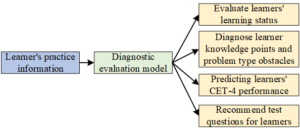
Then, the learner whose state is unstable and whose learning progress is relatively backward, thereby stimulating and promoting the learner’s learning motivation. As shown in Figure 2 and Figure 3.
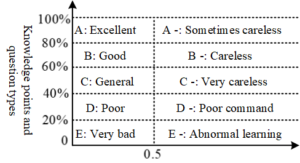
Colleges and universities should first make it clear that what they cultivate is not research-oriented talents but skilled talents. Therefore, for students, the emphasis should be on skills rather than knowledge. In front-line teaching, they should highlight the cultivation of English listening and speaking ability, rather than the knowledge of English grammar to pass examinations. Therefore, the mode of classroom teaching should also be changed accordingly, from the teacher’s lecture to the students’ becoming the main body of the classroom, and learning should extend from the classroom to the outside. Taking students as the center means that teaching materials, teaching process and teaching design should focus on students’ foundation and interests, and take into account the needs of society. Once students can understand, speak English, and use it in their work and life, it will in turn promote their English learning and promote their ability training.

The development system should distinguish between teachers/administrators and students. For teachers/administrators to use the system, most of the system functions can be used, including setting, query, analysis, etc. The flow chart is shown in Figure 4.

For students using the system, they can only query their own scores, as shown in Figure 5.

The use case diagram of the college English achievement analysis system based on the college English education system model is shown in Figure 6.
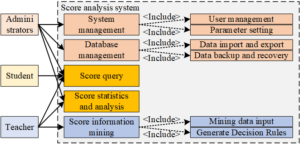
The college English score analysis system based on the model of college English education system is a software running, and the client side is accessed through browser software. The system finally decided to adopt B/S architecture, use SQL Server as the database for development, and use ASP NET as the server side implementation. The overall structure of the score analysis system is shown in Figure 7.
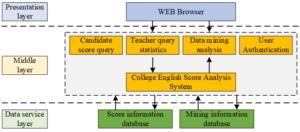
In addition, we will build an applied teaching system of higher English, that is, a trinity teaching model of “multimedia classroom teaching, network platform self-study, and simulation workshop practice”. We will actively use the current modern teaching methods, including smart phones, to create mobile learning methods, and create a multi-functional training base for language learning and application. The applied English teaching system in colleges and universities is expected to be composed of the basic English knowledge module and the specialized applied English module. Among them, the basic English knowledge module belongs to general education, not limited to majors, to promote students’ basic English training.
The login module is the initial user interface of the system. Each user in the system belongs to a certain role, and each role will correspond to a corresponding set of system permissions. After the user passes the authentication, the system will assign different permissions according to the user’s identity, and prompt the user to log in successfully. The sequence diagram is shown in Figure 8.
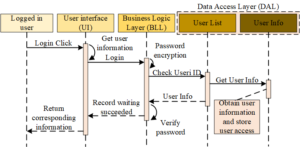
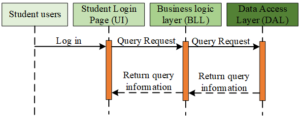
In this model, students can query English scores by test times: use the student number and test times to query the scores of the examinees, and output the total scores, listening scores, grammar and vocabulary scores, reading comprehension scores, translation scores, writing scores, and scoring rates of each sub item score of the examinees in the current test. Through the score query, the examinee can know the extent of his/her English scores in each item. If he/she fails (less than 60 points), he/she can strengthen the weak links in order to achieve good results in the next exam. As shown in Figure 9.
The education of the advanced English basic application ability module should emphasize the cultivation of humanistic quality. Language is not only a tool for communication, but also a very important aspect of people’s quality. The basic English knowledge module of the advanced English application-oriented teaching system is mainly to improve students’ English language sense and basic English skills, and lay a good English foundation for the subsequent professional application English modules. After completing this module, students can engage in simple external communication, mainly involving some routine activities. As shown in Table 2.
| Item No | Fully qualified | Proportion |
| 1 Ask for pronunciation actively | 12 | 12% |
| 2 Don’t ask for pronunciation actively | 62 | 62% |
| 3 Ask grammar actively | 14 | 14% |
| 4 Do not actively consult grammar | 71 | 71% |
| 5 Active speech | 21 | 21% |
| 6 Do not take the initiative to make a speech | 65 | 65% |
| 7 Complete the teaching plan independently | 20 | 20% |
| 8 Do not complete the teaching plan independently | 70 | 71% |
| 9 Actively answer questions | 13 | 13% |
The establishment of multimedia network language autonomous learning center is a beneficial supplement to the basic English teaching system. It can provide a fixed language learning place and environment for students’ autonomous learning, and provide students with different foreign language levels with rich language learning materials The learning materials of the language autonomous learning center are the resources that learners can use in autonomous learning, which can be divided into hardware resources (such as internal LAN, multimedia computers and other modern educational technology equipment that support autonomous learning) and software resources (virtual simulation training system, audio and video materials, multimedia courseware, network courses). The center will create a real language learning situation for students, so that students can receive meaningful input of pure language in a multi-level, multi angle and three-dimensional manner, thus realizing “learning by using”. The establishment of the center promotes students to consolidate their existing English learning knowledge and transform knowledge into skills. One is that the enterprise majors go to the campus to teach together with English teachers, which can be divided into a part of the class hours for enterprise experts, or it can be rotated in a weekly manner. In short, the way is flexible, and the other part is enterprise practice. You can practice after probation, or you can practice in the real situation created by the school before entering the enterprise. The way is more flexible, but the original intention is the same. Students can be closer to enterprises and society. This module needs to take into account learners’ expertise and needs. The classroom teaching of the specialized applied English module can be completed in the simulation workshop established in the school, which opens the way for students to the enterprise. As shown in Tables 3, 4 and 5.
| User | Fast reading | Short news | Short dialogue | Long dialogue | Passage Listening | Banked Cloze | Reading Options | Completion filling | Information matching |
| 1001 | F | T | T | T | T | T | T | T | T |
| 1002 | T | T | F | T | T | T | T | F | T |
| 1003 | T | T | F | T | T | F | T | T | T |
| 1004 | T | T | T | T | T | T | T | T | T |
| 1005 | T | T | F | F | F | T | T | T | T |
| 1006 | T | T | T | T | T | F | F | T | T |
| 1007 | T | F | T | T | F | T | T | F | F |
| 1008 | T | F | T | T | T | T | T | T | F |
| 1009 | T | T | T | F | T | T | F | T | T |
| 1010 | T | T | F | T | T | T | T | F | T |
| Question type | Average score rate |
| Fast reading | 57.03% |
| Short news | 34.62% |
| Reading Choice Questions | 58.68% |
| Completion filling | 53.42% |
| Information matching | 39.43% |
| Student Number | Type Name | Correct Rate |
| 314201010116 | Reading Choice Questions | 0.29 |
| 314201010117 | Reading Choice Questions | 0.23 |
| 314201010118 | Reading Choice Questions | 0.35 |
| 314201010120 | Reading Choice Questions | 0.23 |
| 314201010121 | Reading Choice Questions | 0.84 |
| 314201010123 | Reading Choice Questions | 0.19 |
| 314201010124 | Reading Choice Questions | 0.25 |
| 314201010125 | Reading Choice Questions | 0.14 |
| 314201010127 | Reading Choice Questions | 0.39 |
| 314201010128 | Reading Choice Questions | 0.39 |
The previous chapter introduced the design of the main modules of the system. Based on the experimental feedback, this chapter examines the implementation of the main functional modules of the system, and uses examples to verify the effect and feedback of the results mining and analysis.
The data mining of college English education system driven by information technology is an important function of this system. In order to dig out the influence of students’ study habits and other factors on their grades, the research group distributed a total of 697 questionnaires in 24 classes. As shown in Table 6, it mainly includes class mastery, listening time, reading frequency, vocabulary, 590 valid questionnaires were recovered, and 590 student questionnaires were formed.
| Student ID | Gender | Classroom Mastery | Listening time | Reading frequency | Vocabulary | Achievement |
| 2007421101 | Male | B | \(>\)0.5 | A | A | Excellent |
| 2007421103 | Female | B | 0.5 | A | B | Good |
| 2007421104 | Male | B | 0.5 | B | A | Good |
| 2007421105 | Male | C | 0 | C | B | Commonly |
| 2007421107 | Female | A | 0.5 | A | A | Excellent |
| 2007421108 | Male | B | \(>\)0.5 | A | A | Good |
| 2007421110 | Female | A | 0.5 | B | B | Good |
| 2007421111 | Female | B | 0 | C | B | Commonly |
| 2007421112 | Male | C | 0.5 | C | C | Commonly |
| … | … | … | … | … | … | … |
In this study, in order to make the analysis of teaching performance have a certain pertinence, we divided the above table into “whether the performance is excellent” and “is the performance average”, as shown in Table 7 and 8. Excellent grades have been divided into a separate table. The definition of grades in the general table is actually poor, and it is divided into a separate category. In this way, various factors of poor grades can be analyzed, and the model fitting degree is relatively high.
| Student ID | Gender | Classroom Mastery | Listening time | Reading frequency | Vocabulary | Achievement |
| 2007421101 | Male | B | \(>\)0.5 | A | A | Yes |
| 2007421103 | Female | B | 0.5 | A | B | No |
| 2007421104 | Male | B | 0.5 | B | A | No |
| 2007421105 | Male | C | 0 | C | B | No |
| 2007421107 | Female | A | 0.5 | A | A | Yes |
| 2007421108 | Male | B | \(>\)0.5 | A | A | No |
| 2007421110 | Female | A | 0.5 | B | B | No |
| … | … | … | … | … | … | … |
| Option | A (appropriate) quantity (percentage) | B (excessive) quantity (percentage) | C (too small) quantity (percentage) | Total quantity (percentage) |
| – | 6(13%) | 10(21.7%) | 30(63.2%) | 46(100%) |
It can be seen from the above table that 63.2% of the students believe that the total number of courses in English education is too small, which means that students hope to enrich the courses of this major in order to gain more knowledge and meet their own needs. The purpose of the question design is to investigate students’ suggestions on the proportion of each type of curriculum in the total curriculum. There are three options for students to choose: A increases B decreases C remains unchanged. The feedback table of suggestions is shown in Table 9.
| Option | A Increased quantity (percentage) | B Reduced quantity (percentage) | C Keep constant quantity (percentage) | Total quantity (percentage) |
| Curriculum | A Increased quantity (percentage) | B Reduced quantity (percentage) | C Keep constant quantity (percentage) | Total quantity (percentage) |
| General courses | 1(2.3%) | 40(87%) | 5(10.8%) | 46(100%) |
| Language and language skills courses | 0(0%) | 38(82.6%) | 8(17.4%) | 46(100%) |
| Teacher education courses | 40(87%) | 4(8.7%) | 4(4.3%) | 46(100%) |
| Education Practice Course | 10(21.7%) | 6(13%) | 30(65.3%) | 46(100%) |
According to the survey results in the Table 9, 87% of English education students believe that the proportion of general education courses in the total number of courses in the Foreign Language Department of Yangquan Teachers’ College should be reduced. In addition, 82.6% of English education students believe that the proportion of language skills courses in the total number of courses in the Foreign Languages Department of Yangquan Teachers’ College should also be reduced. At the same time, 87% of the students believe that the proportion of teacher education courses in the total curriculum should be increased. From the above survey results, we can conclude that although general education courses and language skills courses are the main courses and professional courses for English education majors, students still believe that some unnecessary courses need to be deleted. For teacher education courses, students believe that the proportion of such courses should be increased. Students are dissatisfied with the current curriculum. In other words, the existing curriculum for English education majors should be adjusted and improved to meet the needs of students.
In terms of curriculum structure, there are a total of 29 courses for English education majors in a school in Beijing, and the training objectives of each course are briefly described in the table. The design of the question is to investigate the actual needs of nine general education courses, and finally come to the conclusion that what knowledge and skills should really exist when students consider their actual needs. The survey results are shown in Table 10.
| Curriculum | Course content (training objectives) | A Number of people in urgent need (percentage) | B Number of people required for comparison (percentage) | C Number of people not needed (percentage) | D Number of people not required (percentage) |
| 13 Comprehensive English | Comprehensive English Skills | 18(39.1%) | 24(52.2%) | 3(6.5%) | 1(2.2%) |
| 14 Oral English | Oral English Skills | 31(67.4%) | 12(26.1%) | 3(6.5%) | 0(0%) |
| 15 English pronunciation | pronunciation | 33(71.7%) | 13(28.3%) | 0(0%) | 0(0%) |
| 16 English Reading | English reading ability | 29(63.1%) | 12(26.1%) | 3(6.5%) | 2(4.3%) |
| 17 English Listening | Listening skills | 23(50%) | 21(45.7%) | 2(4.3%) | 0(0%) |
| 18 English grammar | How to Use English Skills Correctly | 20(43.5%) | 23(50%) | 2(4.3%) | 1(2.2%) |
| 19 Japanese | Preliminary understanding of Japanese | 1(2.2%) | 5(10.7%) | 33(71.7%) | 7(15.4%) |
| 20 English songs and performances | Singing and performance skills | 2(4.3%) | 5(10.7%) | 29(63.0%) | 10(22.0%) |
| 21 British and American Literature | language knowledge | 4(8.6%) | 3(6.5%) | 20(43.6%) | 19(41.3%) |
From the data in the table above, we can draw the following conclusions: 71.7% of students think that the Japanese curriculum is not very necessary, and 15.4% do not. According to interviews with students, because the teaching time of a second foreign language is quite limited, they can only learn a little, and soon forget what they have learned, and it is difficult to meet the opportunity to use Japanese in their work after graduation. In addition, more than 80% of the students think that Course 20 (English songs and performances) is not a course they love and need, and these two courses have little to do with their future careers, so they can consider replacing them with more effective courses.
In addition, in order to investigate the feedback information of students on the implementation of the credit system and the establishment of elective courses for English education majors, the results are shown in Table 11.
| Option | A Number of people (percentage) | B Number of people (percentage) | C Number of people (percentage) | Total number of people (percentage) |
| – | 46(100%) | – | 0(0%) | 46(100%) |
| – | 7(15.2%) | 39(84.8%) | 0(0%) | 46(100%) |
From the data results in the table above, all students are willing to implement the credit system and arrange elective courses, and ultimately help to rationalize the school curriculum. As for the results, we can see that 84.8% of the students are still very rational about this problem. They believe that the implementation of the credit system and the arrangement of elective courses need to comply with the existing objective reality of the school. On this basis, the implementation of the credit system and the arrangement of elective courses can achieve the maximum effect.
Following the principle of organic unity among talent training objectives, curriculum and the needs of employers, the previous article has finally found many problems in the teaching system of English education major after a comprehensive analysis of the needs of students, teachers and employers. Based on the results of questionnaire analysis, data extraction and model fitting, this chapter will propose a three-dimensional survey solution for the reform of college English teaching mode.
The experimental data used to support the findings of this study are available from the corresponding author upon request.
The authors declared that they have no conflicts of interest regarding this work.
This paper is one of the study results of the research project “The Practice of Cross-cultural Teaching in College English in Application-oriented Universities Based on CBI Teaching Concept”(Item No: XSP2023WXC048).
Revathy, C. and Balaji, P., 2020. Determinants of behavioural intention on e-wallet usage: an empirical examination in amid of covid-19 lockdown period. International Journal of Management (IJM), 11(6), pp.92-104.
1970-2025 CP (Manitoba, Canada) unless otherwise stated.